Original Chemical Series of Pyrimidine Biosynthesis Inhibitors That Boost the Antiviral Interferon Response
- PMID: 28807907
- PMCID: PMC5610480
- DOI: 10.1128/AAC.00383-17
Original Chemical Series of Pyrimidine Biosynthesis Inhibitors That Boost the Antiviral Interferon Response
Abstract
De novo pyrimidine biosynthesis is a key metabolic pathway involved in multiple biosynthetic processes. Here, we identified an original series of 3-(1H-indol-3-yl)-2,3-dihydro-4H-furo[3,2-c]chromen-4-one derivatives as a new class of pyrimidine biosynthesis inhibitors formed by two edge-fused polycyclic moieties. We show that identified compounds exhibit broad-spectrum antiviral activity and immunostimulatory properties, in line with recent reports linking de novo pyrimidine biosynthesis with innate defense mechanisms against viruses. Most importantly, we establish that pyrimidine deprivation can amplify the production of both type I and type III interferons by cells stimulated with retinoic acid-inducible gene 1 (RIG-I) ligands. Altogether, our results further expand the current panel of pyrimidine biosynthesis inhibitors and illustrate how the production of antiviral interferons is tightly coupled to this metabolic pathway. Functional and structural similarities between this new chemical series and dicoumarol, which was reported before to inhibit pyrimidine biosynthesis at the dihydroorotate dehydrogenase (DHODH) step, are discussed.
Keywords: antiviral agents; innate immunity; interferons; pyrimidine metabolism.
Copyright © 2017 Lucas-Hourani et al.
Figures

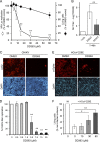
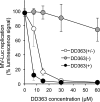
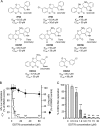
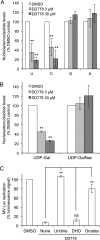
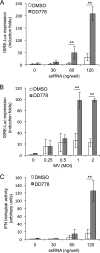
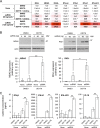


Similar articles
-
Novel Dihydroorotate Dehydrogenase Inhibitors with Potent Interferon-Independent Antiviral Activity against Mammarenaviruses In Vitro.Viruses. 2020 Jul 29;12(8):821. doi: 10.3390/v12080821. Viruses. 2020. PMID: 32751087 Free PMC article.
-
[Stimulation of the antiviral innate immune response by pyrimidine biosynthesis inhibitors: a surprise of phenotypic screening].Med Sci (Paris). 2015 Jan;31(1):98-104. doi: 10.1051/medsci/20153101019. Epub 2015 Feb 6. Med Sci (Paris). 2015. PMID: 25658737 Review. French.
-
Original 2-(3-alkoxy-1H-pyrazol-1-yl)pyrimidine derivatives as inhibitors of human dihydroorotate dehydrogenase (DHODH).J Med Chem. 2015 Jan 22;58(2):860-77. doi: 10.1021/jm501446r. Epub 2015 Jan 6. J Med Chem. 2015. PMID: 25558988
-
Inhibiting pyrimidine biosynthesis impairs Ebola virus replication through depletion of nucleoside pools and activation of innate immune responses.Antiviral Res. 2018 Oct;158:288-302. doi: 10.1016/j.antiviral.2018.08.012. Epub 2018 Aug 23. Antiviral Res. 2018. PMID: 30144461 Free PMC article.
-
DHODH inhibitors: What will it take to get them into the clinic as antivirals?Antiviral Res. 2025 Apr;236:106099. doi: 10.1016/j.antiviral.2025.106099. Epub 2025 Feb 10. Antiviral Res. 2025. PMID: 39938808 Review.
Cited by
-
IMU-838, a Developmental DHODH Inhibitor in Phase II for Autoimmune Disease, Shows Anti-SARS-CoV-2 and Broad-Spectrum Antiviral Efficacy In Vitro.Viruses. 2020 Dec 5;12(12):1394. doi: 10.3390/v12121394. Viruses. 2020. PMID: 33291455 Free PMC article.
-
Novel Dihydroorotate Dehydrogenase Inhibitors with Potent Interferon-Independent Antiviral Activity against Mammarenaviruses In Vitro.Viruses. 2020 Jul 29;12(8):821. doi: 10.3390/v12080821. Viruses. 2020. PMID: 32751087 Free PMC article.
-
An open-label randomized controlled trial of leflunomide in patients with acute SARS-CoV-2 omicron variant infection.Front Med (Lausanne). 2023 Jul 18;10:1218102. doi: 10.3389/fmed.2023.1218102. eCollection 2023. Front Med (Lausanne). 2023. PMID: 37534317 Free PMC article.
-
Modulation of nucleotide metabolism by picornaviruses.PLoS Pathog. 2024 Mar 8;20(3):e1012036. doi: 10.1371/journal.ppat.1012036. eCollection 2024 Mar. PLoS Pathog. 2024. PMID: 38457376 Free PMC article.
-
Unlocking STING as a Therapeutic Antiviral Strategy.Int J Mol Sci. 2023 Apr 18;24(8):7448. doi: 10.3390/ijms24087448. Int J Mol Sci. 2023. PMID: 37108610 Free PMC article. Review.
References
-
- Bonavia A, Franti M, Pusateri Keaney E, Kuhen K, Seepersaud M, Radetich B, Shao J, Honda A, Dewhurst J, Balabanis K, Monroe J, Wolff K, Osborne C, Lanieri L, Hoffmaster K, Amin J, Markovits J, Broome M, Skuba E, Cornella-Taracido I, Joberty G, Bouwmeester T, Hamann L, Tallarico JA, Tommasi R, Compton T, Bushell SM. 2011. Identification of broad-spectrum antiviral compounds and assessment of the druggability of their target for efficacy against respiratory syncytial virus (RSV). Proc Natl Acad Sci U S A 108:6739–6744. doi:10.1073/pnas.1017142108. - DOI - PMC - PubMed
-
- Wang QY, Bushell S, Qing M, Xu HY, Bonavia A, Nunes S, Zhou J, Poh MK, Florez de Sessions P, Niyomrattanakit P, Dong H, Hoffmaster K, Goh A, Nilar S, Schul W, Jones S, Kramer L, Compton T, Shi PY. 2011. Inhibition of dengue virus through suppression of host pyrimidine biosynthesis. J Virol 85:6548–6556. doi:10.1128/JVI.02510-10. - DOI - PMC - PubMed
MeSH terms
Substances
LinkOut - more resources
Full Text Sources
Other Literature Sources
Medical

